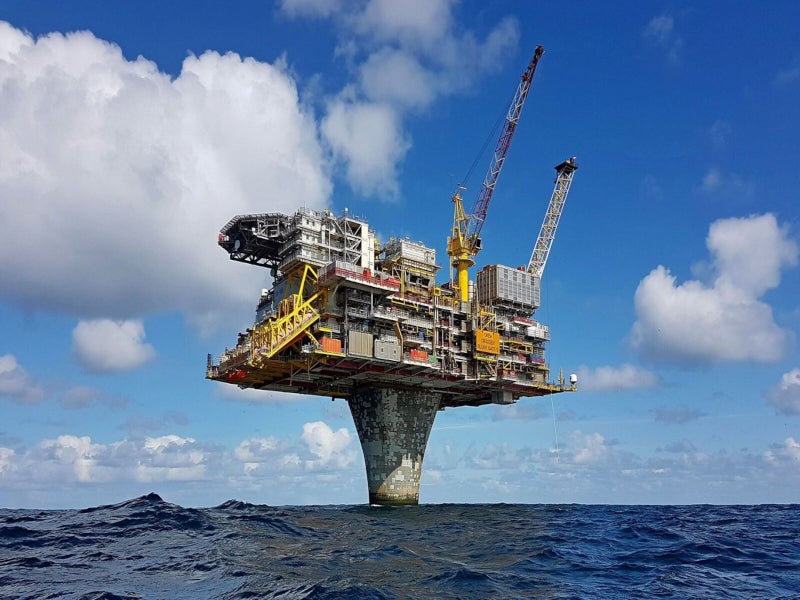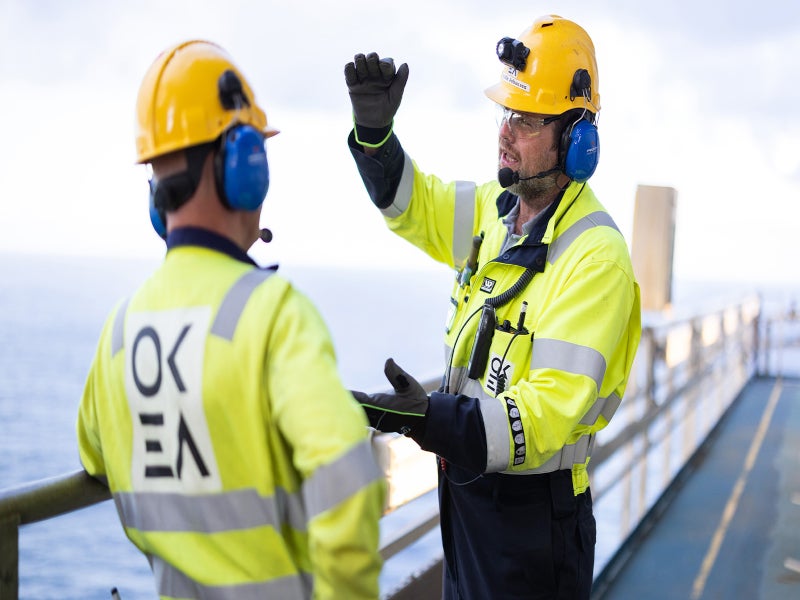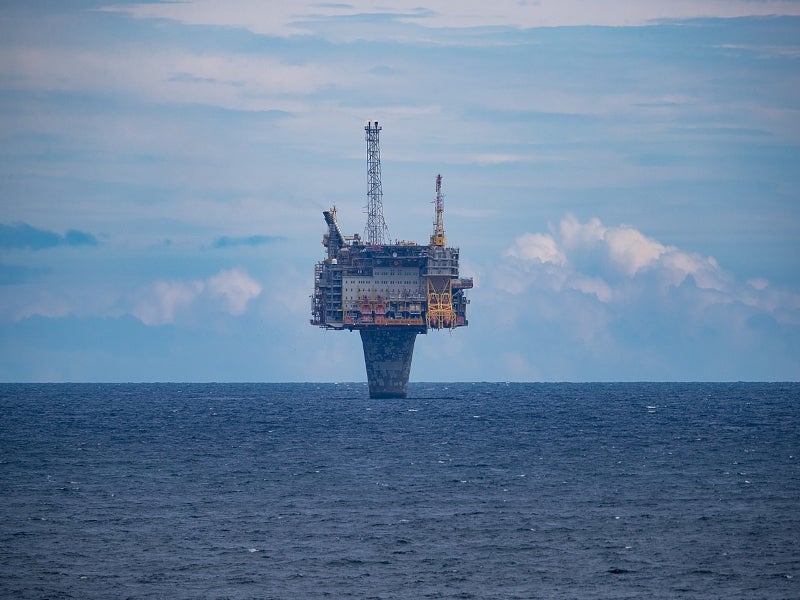Draugen is an offshore oil field with associated gas, located at a water depth of 250m in the southern part of the Norwegian Sea.
The field lies in production licence PL093 of block 6407/9 in the Haltenbanken area, which is situated about 140km from Kristiansund, Norway.
The Draugen field was originally developed and operated by Shell. OKEA acquired Shell’s 44.56% interest in the field and became the operator in 2018. The other two partners are Petoro (47.88%) and M Vest Energy (7.56%).
The plan for development and operation (PDO) of the field was approved in 1988, and production from the field commenced in October 1993.
Several projects are underway to ensure future profitable production from the Draugen field, including initiatives such as power from shore, extending the field’s operational life and upgrading subsea pumps. The measures are expected to extend the life of the Draugen oil field into the 2040s.
The Hasselmus gas discovery, the first tie-back to the Draugen production platform, began production in 2023. It added more than 4,000 barrels of oil equivalents per day (boepd) to the Draugen field production.
Draugen field discovery
The field was discovered in 1984 by the first well drilled in the block. The discovery wellbore was a wild cat well designated 6407/9-1.
Four more appraisal wells were drilled in the following year. The sixth appraisal well was drilled in 1986. It was suspended initially but re-entered later.
The last three appraisal wells were drilled in 1993, 1999 and 2003.
Geology
The Draugen field produces oil primarily from two reservoirs. The main reservoir contains sandstone of Rogn formation, found to be of the late Jurassic age. The other deposit, located in the west, is the Garn formation of the middle Jurassic age. The Rogn and Garn deposits are homogeneous and both lie at a depth of 1,650m.
Draugen field development
The Draugen field was initially developed with five subsea wells connected to a central platform. The field currently has six platform wells and eight subsea wells. Of these, 11 are production wells.
The field was developed using a fixed concrete structure with integrated topside facilities, and production comes from both platform and subsea wells. Stabilised oil is stored in tanks located at the base of the structure, and two pipelines link the facility to a floating loading buoy.
The Garn reservoir in the west of Draugen was developed with two subsea wells. It began production in late 2001. The Rogn reservoir was developed with two subsea wells in 2002 and production from the reservoir began in November of the same year. One subsea well was drilled in each of these reservoirs in 2007. The new wells at the Garn and Rogn were named D3 and E3. Production from the two subsea wells commenced in 2008.
In 2021, an exemption from the PDO was granted for the subsea tie-back of the 6407/9-9 (Hasselmus) discovery.
Subsea system
The subsea system at Draugen includes two water injection wells, two oil production satellite wells and a gas injection satellite well. The system required nine vertical subsea trees of 5,000psi. The subsea wells were tied to the common Draugen platform.
Production
Shell began producing oil at the Draugen field in October 1993. The use of 4D seismic technology helped Shell to increase the production life of the Draugen field.
Currently, the field yields an output of more than 17,000 barrels of oil per day (bpd) from 11 production wells.
Pipeline
The Garn West reservoir is connected to the Draugen platform by a 3.3 km-long pipeline. The pipeline laid via the Garn West reservoir connects the Rogn deposit to the project platform.
The oil is offloaded through a floating loading buoy and then exported by tankers. The gas is transported via the Asgard Transport System to the Karsto terminal.
Draugen electrification project
OKEA signed a Letter of Intent with Aker Solutions for the electrification of the Draugen field in February 2023.
Replacing the current gas turbine power generation at the offshore platform with shore-based electrification will significantly reduce CO₂ emissions from Draugen’s oil and gas production by as much as 200,000t of CO₂ per year. Extending the field’s lifetime could result in an additional 20 years of production and value creation.
The project development has started and is expected to be completed in 2026.
Contractors involved
The engineering, procurement, and construction contract for subsea well facilities at the Draugen field was awarded to FMC Technologies in 1990. FMC designed the subsea installations for diverless installation, operation and maintenance.
The marine installation contract for Draugen D3 and E3 development, which included flexible pipe and umbilical system, was given to Acergy in March 2007. Acergy installed the flexible pipe and umbilical system, a 2.3km gas lift and 2.4km production flowlines at Draugen in 2008. Normand Mermaid and Acergy Eagle ships were used for the marine installations.
Acergy awarded the water injection flowlines supply contract to NKT Flexibles in May 2010. NKT Flexibles supplied two water injection flowlines one for the re-injection of produced water and another for that of seawater.
Bjorge Eureka, the Norwegian subsidiary of Bjorge, was awarded a contract in July 2009 to upgrade the generator system at the Draugen platform and supply centrifugal pumps to the platforms.
Aker Offshore Partner (a subsidiary of Aker Solutions) set up a water re-injection system at the Draugen field. The contract was awarded by Shell in December 2009. The contractual scope includes engineering, procurement, construction and installation (EPCI) of the reinjection system.
Aker Solutions was also selected as the main contractor for EPCI works for the Draugen electrification project.
AGR provided a history-matched reservoir model that allowed OKEA to optimise reservoir management, forecast future production and plan in-fill drilling targets.
Altris supplied document viewing and management software to Shell during the field development.
ABB was awarded a contract to supply process automation, safety and information management systems to monitor and control the subsea and topside production processes at the Draugen field.
In March 2021, Proserv was chosen as the service provider for the overhaul and refurbishment of a part of the existing original equipment manufacturer’s (OEM) subsea production control system on the Draugen field. The company also secured an additional upgrade contract in 2022. It will provide condition-based maintenance services for the field.
OKEA signed a five-year agreement with CCB Subsea to serve as the service provider for the overhaul and refurbishment of existing subsea production systems on Draugen in June 2021. This aligns with OKEA’s strategy to sustain production at the Draugen field until 2040.
CCB Subsea has provided general engineering and operational support to OKEA in the planning and execution of offshore subsea operations, since OKEA took over operatorship of the Draugen field in 2019.






